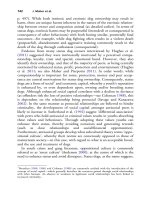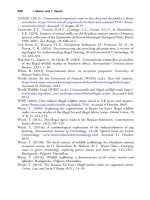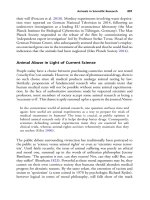The palgrave international handbook of a 148
Bạn đang xem bản rút gọn của tài liệu. Xem và tải ngay bản đầy đủ của tài liệu tại đây (37.27 KB, 1 trang )
Status Dogs
139
appropriate care for the animal. Hughes et al. (2011) noted the regularity with
which dogs passed through the hands of young people, particularly as so little
was known about the outcome for the dogs passed on. With status also comes
competition with peers, sometimes resulting in a desire for a different (better)
dog. These scenarios can lead to neglect of the animal and, ultimately, its
abandonment. This issue is not just an owner’s problem, but a policy,
enforcement and social one. The status dog label is often a death sentence
for dogs with irresponsible owners, as the dog is more likely to come to the
attention of neighbours and local or housing authorities, thereby increasing the
likeliness of abandonment. Abandoned dogs are also less likely to be returned
to their owner and are likely to meet a natural or unnatural death:
• from malnourishment or injury when abandoned.
• resulting from the harmful effects of long-term kennelling (see also, Taylor
and Mills 2007).
• due to limited space in kennels (council or charity) the dog is killed.
• due to injuring another person, assistance dog or other animals the dog is
killed.
• due to being identified as a banned breed and must be destroyed
• when used as a bait dog and is killed.
Prevalence and Problems with Measurement
It is currently impossible to accurately identify the scale of the status dog
problem. There is very little quantitative data available on the extent of status
dog ownership and, even less so, on resulting harms. Compulsory microchipping and keeper registration has just been introduced in England,
Scotland and Wales: from April 2016, it has been a legal requirement in
Great Britain for all dogs to be microchipped with up-to-date contact details
(for example see the Microchipping of Dogs (England) Regulations 2015).
However, the accessibility and utility of the data that this will eventually
yield is currently unquantifiable. Moreover, there is currently no centralised
record keeping of dog breeding; this data is held by the (local) licensing
authorities. The following information is available to provide some insight
into the prevalence of the status dog problem:
1. The number of dangerous dogs seized and their outcomes (including their
destruction) is recorded and published online monthly by the London
Status Dog Unit (Metropolitan Police Service 2016). For example, in









